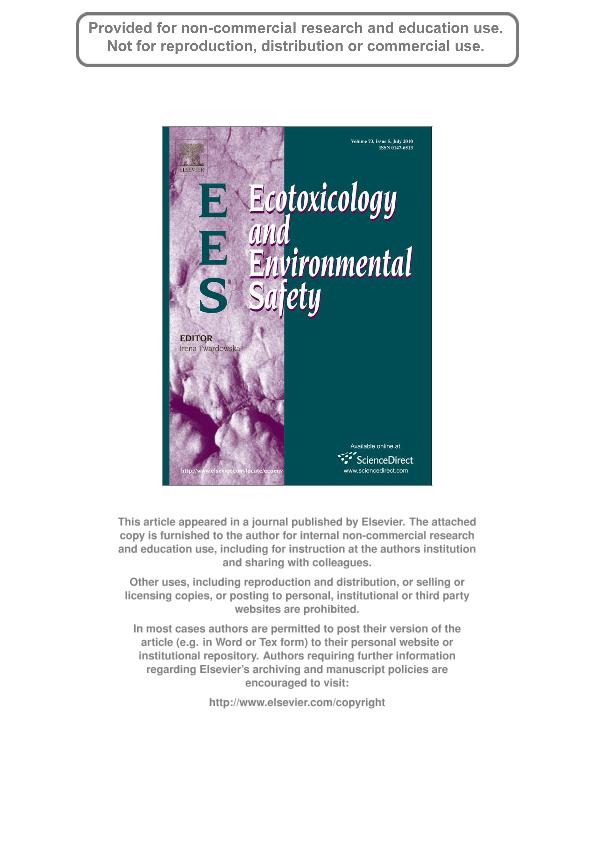Mostrar el registro sencillo del ítem
dc.contributor.author
Garcia, M. E.
dc.contributor.author
Rodrigues Capitulo, Alberto

dc.contributor.author
Ferrari, Lucrecia

dc.date.available
2017-09-15T15:30:13Z
dc.date.issued
2010-02
dc.identifier.citation
Garcia, M. E.; Rodrigues Capitulo, Alberto; Ferrari, Lucrecia; Age-related differential sensitivity to cadmium in Hyalella curvispina (Amphipoda) and implications in ecotoxicity studies; Elsevier Inc; Ecotoxicology and Environmental Safety; 73; 5; 2-2010; 771-778
dc.identifier.issn
0147-6513
dc.identifier.uri
http://hdl.handle.net/11336/24350
dc.description.abstract
The standardization of toxicity tests requires the selection of the most suitable test species and their developmental stages, as well as the selection of the appropriate assay matrix and the evaluation of the sensitivity of the test species to the reference toxicants. International protocols recommend the use of the amphipod Hyalella azteca from the Northern Hemisphere for sediment toxicity tests. We selected the widely distributed amphipod Hyalella curvispina, representative of pleustonic, epiphitic and zoobenthic assemblages in austral South America, as test species to be used in regional studies. Our goals were to evaluate the sensitivity of three developmental stages of H. curvispina to cadmium as a reference toxicant and to select the most suitable age and exposure time for aquatic ecotoxicity assessment. The three ages were highly susceptible to cadmium, with sensitivities: neonates > adults > juveniles. Our results validate the use of the native H. curvispina as a standard species for ecotoxicological assessment studies.
dc.format
application/pdf
dc.language.iso
eng
dc.publisher
Elsevier Inc

dc.rights
info:eu-repo/semantics/openAccess
dc.rights.uri
https://creativecommons.org/licenses/by-nc-nd/2.5/ar/
dc.subject
Hyalella Curvispina
dc.subject
Life Stage
dc.subject
Cadmium Sensitivity
dc.subject
Standard Test
dc.subject.classification
Bioquímica y Biología Molecular

dc.subject.classification
Ciencias Biológicas

dc.subject.classification
CIENCIAS NATURALES Y EXACTAS

dc.title
Age-related differential sensitivity to cadmium in Hyalella curvispina (Amphipoda) and implications in ecotoxicity studies
dc.type
info:eu-repo/semantics/article
dc.type
info:ar-repo/semantics/artículo
dc.type
info:eu-repo/semantics/publishedVersion
dc.date.updated
2017-09-01T18:39:06Z
dc.journal.volume
73
dc.journal.number
5
dc.journal.pagination
771-778
dc.journal.pais
Estados Unidos

dc.description.fil
Fil: Garcia, M. E.. Consejo Nacional de Investigaciones Científicas y Técnicas. Centro Científico Tecnológico Conicet - La Plata. Instituto de Limnología "Dr. Raúl A. Ringuelet". Universidad Nacional de La Plata. Facultad de Ciencias Naturales y Museo. Instituto de Limnología; Argentina. Universidad Nacional de Luján. Instituto de Ecología y Desarrollo Sustentable. Consejo Nacional de Investigaciones Científicas y Técnicas. Oficina de Coordinación Administrativa Parque Centenario. Instituto de Ecología y Desarrollo Sustentable; Argentina
dc.description.fil
Fil: Rodrigues Capitulo, Alberto. Consejo Nacional de Investigaciones Científicas y Técnicas. Centro Científico Tecnológico Conicet - La Plata. Instituto de Limnología "Dr. Raúl A. Ringuelet". Universidad Nacional de La Plata. Facultad de Ciencias Naturales y Museo. Instituto de Limnología; Argentina
dc.description.fil
Fil: Ferrari, Lucrecia. Provincia de Buenos Aires. Gobernación. Comisión de Investigaciones Científicas; Argentina. Universidad Nacional de Luján. Instituto de Ecología y Desarrollo Sustentable. Consejo Nacional de Investigaciones Científicas y Técnicas. Oficina de Coordinación Administrativa Parque Centenario. Instituto de Ecología y Desarrollo Sustentable; Argentina
dc.journal.title
Ecotoxicology and Environmental Safety

dc.relation.alternativeid
info:eu-repo/semantics/altIdentifier/url/http://www.sciencedirect.com/science/article/pii/S0147651309002991
dc.relation.alternativeid
info:eu-repo/semantics/altIdentifier/doi/http://dx.doi.org/10.1016/j.ecoenv.2009.12.022
Archivos asociados
